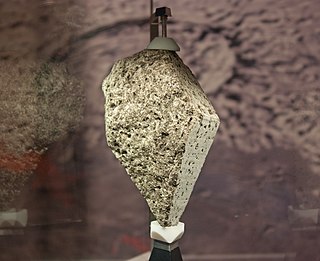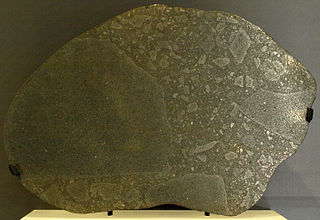Related Research Articles

A meteorite is a rock that originated in outer space and has fallen to the surface of a planet or moon. When the original object enters the atmosphere, various factors such as friction, pressure, and chemical interactions with the atmospheric gases cause it to heat up and radiate energy. It then becomes a meteor and forms a fireball, also known as a shooting star; astronomers call the brightest examples "bolides". Once it settles on the larger body's surface, the meteor becomes a meteorite. Meteorites vary greatly in size. For geologists, a bolide is a meteorite large enough to create an impact crater.

A lunar meteorite is a meteorite that is known to have originated on the Moon. A meteorite hitting the Moon is normally classified as a transient lunar phenomenon.

Heat Shield Rock is a basketball-sized iron-nickel meteorite found on the Meridiani Planum plain of Mars by the Mars rover Opportunity in January 2005.

Orgueil is a scientifically important carbonaceous chondrite meteorite that fell in southwestern France in 1864.

Moon rock or lunar rock is rock originating from Earth's Moon. This includes lunar material collected during the course of human exploration of the Moon, and rock that has been ejected naturally from the Moon's surface and landed on Earth as meteorites.

Nakhla is a Martian meteorite which fell in Egypt in 1911. It was the first meteorite reported from Egypt, the first one to suggest signs of aqueous processes on Mars, and the prototype for Nakhlite type of meteorites.
El Ali is a district in the central Hiran region of Somalia. El Ali has a population of around 120,000 inhabitants. The broader El Ali District has a total population of 543,345 residents. El Ali means. El-Ali's residents belong to the Galje'el Subclan of Dirisame.
The Carancas impact event refers to the fall of the Carancas chondritic meteorite on September 15, 2007, near the village of Carancas in Peru, close to the Bolivian border and Lake Titicaca. The impact created a small crater in the clay soil and scorched earth around its location. A local official, Marco Limache, said that "boiling water started coming out of the crater, and particles of rock and cinders were found nearby", as "fetid, noxious" gases spewed from the crater. Surface impact occurred above 3,800 metres (12,500 ft).

2008 TC3 (Catalina Sky Survey temporary designation 8TA9D69) was an 80-tonne (80-long-ton; 90-short-ton), 4.1-meter (13 ft) diameter asteroid that entered Earth's atmosphere on October 7, 2008. It exploded at an estimated 37 kilometers (23 mi) above the Nubian Desert in Sudan. Some 600 meteorites, weighing a total of 10.5 kilograms (23.1 lb), were recovered; many of these belonged to a rare type known as ureilites, which contain, among other minerals, nanodiamonds.

Enstatite chondrites are a rare form of meteorite, rich in the mineral enstatite. Only about 200 E-Type chondrites are currently known, comprising about 2% of the chondrites that fall on Earth. There are two main subtypes: EH and EL, classified based on their iron content.
Tranquillityite is silicate mineral with formula (Fe2+)8Ti3Zr2 Si3O24. It is mostly composed of iron, oxygen, silicon, zirconium and titanium with smaller fractions of yttrium and calcium. It is named after the Mare Tranquillitatis (Sea of Tranquility), the place on the Moon where the rock samples were found during the 1969 Apollo 11 mission. It was the last mineral brought from the Moon which was thought to be unique, with no counterpart on Earth, until it was discovered in Australia in 2011.

The Tissint meteorite is a Martian meteorite that fell in Tata Province in the Guelmim-Es Semara region of Morocco on July 18, 2011. Tissint is the fifth Martian meteorite that people have witnessed falling to Earth, and the first since 1962. Pieces of the meteorite are on display at several museums, including the Museum of Natural History of Vienna and the Natural History Museum in London.
Winonaites are a group of primitive achondrite meteorites. Like all primitive achondrites, winonaites share similarities with chondrites and achondrites. They show signs of metamorphism, partial melting, brecciation and relic chondrules. Their chemical and mineralogical composition lies between H and E chondrites.
This is a glossary of terms used in meteoritics, the science of meteorites.

The Chelyabinsk meteorite is the fragmented remains of the large Chelyabinsk meteor of 15 February 2013 which reached the ground after the meteor's passage through the atmosphere. The descent of the meteor, visible as a brilliant superbolide in the morning sky, caused a series of shock waves that shattered windows, damaged approximately 7,200 buildings and left 1,491 people injured. The resulting fragments were scattered over a wide area.
Edscottite is an iron carbide mineral, with the formula Fe5C2. It was previously known to occur during iron smelting, but in 2019 was identified as occurring in nature, but not naturally occurring on earth, when it was discovered in a meteorite.
Elaliite is a mineral with formula Fe9PO12 (or Fe2+8Fe3+(PO4)O8) that was first synthesized in a laboratory in the 1980s and later identified in natural material in 2022 at which time the official mineral designation was given. The mineral is orthorhombic, with space group Cmmm (space group 65).
Elkinstantonite is a mineral with formula Fe4(PO4)2O that was first generated in a laboratory in the 1980s and first identified from natural origins in 2022, when the official mineral designation was also given. It is monoclinic, with space group P21/c (space group 14).
References
- 1 2 3 4 5 6 7 "Meteoritical Bulletin: Entry for El Ali". www.lpi.usra.edu. Retrieved 2022-11-30.
- 1 2 "U of A scientists help identify two new minerals found in 'curious' meteorite". edmontonjournal. Retrieved 2022-11-30.
- 1 2 WEI-HAAS, Maya (2022-12-14). "'Alien' minerals never found on Earth identified in meteorite". National Geographic - Science. Archived from the original on December 14, 2022. Retrieved 2023-04-10.
- ↑ "Somalia meteorite: Joy as scientists find two new minerals". BBC News. 2022-11-29. Retrieved 2022-11-29.
- 1 2 "In meteorite, Alberta researchers discover 2 minerals never before seen on Earth | Globalnews.ca". Global News. Retrieved 2022-11-29.
- ↑ MacPherson, Adrianna (2022-11-28). "New minerals discovered in massive meteorite may reveal clues to asteroid formation" (Press release). Alberta, Canada: University of Alberta. Retrieved 2022-11-30.